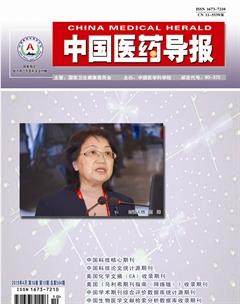TSG—6抑制瘢痕形成、促進腱—骨愈合作用的研究進展
徐志 劉毅 鄒剛
[摘要] 運動系統損傷包括肌腱、韌帶、軟骨等軟組織損傷,是我國青壯年常見病。因原組織再生能力較弱,瘢痕形成及局部炎癥演變,增加了后期創傷型關節炎的風險。目前針對運動系統損傷治療采用生長因子干預較為熱門,TSG-6被發現可調節損傷信號的反應而減少炎癥,防止纖維血管組織的形成,改善了愈合肌腱-骨界面的結構和附著強度,具有促進軟骨形成和腱-骨愈合作用。本文就TSG-6抑制瘢痕形成、促進腱-骨愈合、保護軟骨方面的研究作一綜述。
[關鍵詞] TSG-6;腱-骨愈合;軟骨修復;肌腱損傷;干細胞移植
[中圖分類號] R619.6 [文獻標識碼] A [文章編號] 1673-7210(2019)04(a)-0056-04
[Abstract] Locomotor system injuries includes the injuries of tendons, ligaments, cartilage and other soft tissue injuries, which is a common disease in young adults in China. Because the original tissue regeneration ability is weak, scar formation and local inflammation evolution increase the risk of later traumatic arthritis. The ability of the original tissue regeneration is weak, leading to scar formation and local inflammation evolution, which increase the risk of later traumatic arthritis. At present, the use of growth factor intervention for the treatment of locomotor system injury is more popular. TSG-6 was found to regulate the response of injury signals to reduce inflammation, prevent the formation of fibrous vascular tissue, improve the structure and adhesion strength of the healing tendon-bone interface, which promotes cartilage formation and tendon-bone healing. This paper will elaborate on the study of TSG-6 inhibition of scar formation, promotion of tendon-bone healing, and protection of cartilage.
[Key words] TSG-6; Tendon-bone healing; Cartilage repair; Tendon injury; Stem cell transplantation
肌腱損傷是常見的軟組織損傷,腱-骨結構損壞自身修復愈合能力較弱。隨著損傷時間的延長逐漸出現疼痛、關節活動受限、關節不穩、關節退行性變等多種并發癥。肩袖損傷、前交叉韌帶(ACL)撕裂是常見的運動損傷。骨-髕骨肌腱-骨移植(BPTB)的應用多年來一直被認為是治療ACL撕裂“金標準”[1],然而,許多患者可能會經歷移植失敗,需要修改ACL重建才能恢復正常生活。重建ACL的結果通常比第一次手術更糟糕,ACL重建手術失敗率3~4倍于初次手術[2],肌腱-骨連接點的損傷使肌腱與骨交界處的纖維軟骨形成困難,瘢痕愈合的結果使肌腱附著點不穩定,術后肌腱殘端和骨插入點的恢復能力受到很大限制,容易發生二次撕裂[3]。肌腱-骨連接界面修復和重建的核心問題是肌腱與骨之間的纖維軟骨層在肌腱-骨連接界面的修復,以及正常肌腱-骨連接結構的形成[4]。隨著生物科技的進步至目前為止國內外已有多種新型治療方式報道[5-9]。近年來基礎研究和臨床實踐中發現小分子化合物TSG-6能控制局部炎癥,抑制瘢痕組織形成,有利于創傷后腱骨愈合。
1 TSG-6的結構及作用
TSG-6是TNF刺激的基因-6的分泌蛋白產物,在大多數情況下,TSG-6具有抗炎和組織保護作用。TSG-6是由間充質干細胞/基質細胞(MSCs)對炎癥信號的反應產生的,它介導了許多免疫調節和修復活動。TSG-6是一種相對較小的蛋白質,分子量僅為35~38 kD,主要由兩個模塊結構域組成。TSG-6已發現的生理作用包括免疫和基質細胞功能的調節及其對細胞外基質形成及重塑。TSG-6有能力調節基質組織,控制基質分子與細胞表面受體和細胞外信號因子(如趨化因子)的結合,這可能是其多種功能的基礎。在這方面,TSG-6與大量配體相互作用,如糖胺聚糖(GAGS)、蛋白多糖(PG)核心蛋白和其他基質成分,并直接與多種趨化因子和骨形態發生蛋白(BMPs)結合。
2 TSG-6抑制瘢痕形成、促進腱-骨愈合及保護軟骨的作用
2.1 TSG-6抑制瘢痕形成
纖維化和瘢痕是許多疾病過程的結束階段。膠原纖維最初在損傷組織的修復過程中提供了必要的強度,通常會大量合成,成為限制組織內源性細胞再生的不可逆性的纖維沉積物[10]。TSG-6可以抑制膠原Ⅰ、Ⅱ的合成,誘導成纖維細胞的凋亡并減輕肥大的瘢痕形成。Wang等[11]在12只兔耳上作6 mm全厚度圓形傷口。將TSG-6和PBS分別在右側和左側耳廓傷口內注射。檢測炎癥因子IL-1β、IL-6、TNF-α及Ⅰ、Ⅲ型膠原的表達,評價瘢痕形成程度。結果提示TSG-6在兔耳創面愈合和瘢痕化過程中具有抗炎作用,顯著減少增生性瘢痕的形成。張蘇文等[12]發現TSG-6在體外能夠抑制人病理性瘢痕成纖維細胞的增殖并促進其凋亡,并提出TSG-6對細胞的抑制作用可能與TSG-6抑制PCNA基因表達有關。Foskett等[13]在博萊霉素所致肺損傷小鼠模型中,我們發現抑制炎癥早期可明顯降低肺纖維化程度,改善動脈血氧飽和度和存活率。
2.2 TSG-6對腱骨愈合的促進作用
運動系統損害后關節內外出血、腫脹、炎性反應、瘢痕愈合增加腱骨愈合難度,若能抑制炎性反應及瘢痕組織形成,創造物瘢痕愈合環境有利于創傷后腱骨愈合。Cheng等[14]對45只大鼠行單側斷端離斷及岡上肌腱修復術。結果顯示實驗組的極限應力明顯高于對照組。從中發現TSG-6介導TDSCs的功能,改善肌腱-骨界面的結構和附著強度。Inoue等[15]發現早幼粒白血病鋅指(PLZF)是上調基因之一,TSG-6基因是成骨細胞分化過程中下調的基因之一。實驗中腺病毒載體介導TSG-6在hMSCs中的過表達,阻斷BMP誘導的成骨細胞分化,抑制成骨細胞特異性基因COL1A1和ALP的表達。TSG-6的這些作用有望使骨骼中的形成/吸收平衡向吸收方向轉變,這可能至少部分地解釋了炎癥性關節炎的骨丟失。TSG-6的過度表達為平滑肌及內皮細胞提供了生長優勢,有助于運動系統損傷后局部血供的重建,對腱骨愈合有促進作用。
2.3 TSG-6保護軟骨作用
TSG-6是根據一系列炎癥介質而表達的,并且已經在OA患者的滑液中高水平檢測到。TSG-6已被證明可以保護關節免受炎性關節炎的損傷,其含量減少可加劇導致炎性關節炎的嚴重程度。Lympany等[16]構建軟骨降解的小鼠OA模型,以10~12周齡雄性TSG-6/、TSG-6+/+和TSG-TG(過表達)小鼠為實驗對象,切斷半月板-脛骨內側韌帶(DMM)誘導OA。假手術組僅行囊切開術。對側膝關節行DMM術小鼠和假手術小鼠均作為對照組。術后8~12周,根據OARSI指南進行關節切片,評估軟骨退化的嚴重程度。與對照組相比,TSG-6在WT小鼠的DMM手術后6 h受到高度調節。15個炎癥相關基因如IL-1α和Adamts 5在TSG-6中顯著高于DMM對照組小鼠。TSG-6轉基因小鼠在術后12周表現出與WT組相比軟骨降解減少。實驗結果表明TSG-6對小鼠OA具有抗炎和軟骨保護作用。
3 TSG-6在關節炎進程中發揮的作用
3.1 TSG-6控制關節炎癥的作用
TSG-6含有透明質酸結合的連接結構域,并且可以與在與炎癥相關的蛋白酶網絡中重要的α-抑制劑(I/I)形成穩定的共價復合物。許多研究證實了TSG-6的抗炎作用[17-18]。既往研究證明關節疾病(包括OA和RA)患者的滑膜液和軟骨中存在TSG-6[19],然而同期血清TSG-6水平升高不明顯。IL-1、TNF等炎癥因子和PDGF、TGF-β等轉化因子均可誘導滑膜細胞以及軟骨細胞TSG-6表達,有研究[20]表明將TSG-6基因從BALB/c小鼠中去除后,蛋白多糖誘導的關節炎的進展和嚴重程度明顯高于正常小鼠。炎癥早期關節滑膜有大量白細胞浸潤。血清IL-6、IL-1等炎性細胞因子水平升高,損傷關節內炎癥介質增多,導致軟骨退化、骨侵蝕、強直和畸形。Liu等[21]發現MSCs和TSG-6對活化的小膠質細胞的促炎癥介質的表達有明顯的抑制作用。TSG-6沉默后,MSCs對小膠質細胞的影響減弱。TSG-6對LPS刺激的BV2小膠質細胞核因子(NF)-κB和絲裂原活化蛋白激酶(MAPK)通路的激活有明顯的抑制作用。Watt等[22]在牛津大學的一份研究中表明自身免疫性關節炎的小鼠模型也與TSG-6的抗炎和軟骨保護作用有關。
3.2 TSG-6加重關節炎癥的作用
TSG-6活性也是膝關節炎癥的特異性標志,炎癥與膝OA的發生和進展有關[23-24],TSG-6在慢性OA中的主要作用似乎不同于急性關節損傷或自身免疫性關節炎中表現出抗炎、軟骨保護的作用。Broeren等[25]將重組TSG-6或慢病毒TSG-6載體注入C57BL/6J小鼠與熒光素酶對照組相比TSG-6表達的基因治療不能在實驗性骨關節炎中起到軟骨保護作用,反而導致異位骨形成增加。Chou等[26]對25例膝骨關節炎滑膜液(SFS)中TSG-6介導的重鏈轉移(TSG-6)活性及其與炎癥介質的關系進行定量分析。結果表明雖然TSG-6在損傷關節軟骨和半月板軟骨及細胞因子處理的軟骨細胞中高表達,但IαⅠ復合物(含HC1)的軟骨表達很少或不表達。TSG-6破壞了HA-aggrecan的組裝。IαI由軟骨外供應,僅穿透軟骨表面,限制TSG-6活性(HC向該區域的轉移)。OA軟骨中深區的TSG-6可能會阻斷基質的組裝,導致骨關節炎的合成徒勞無功,增加OA進展的風險。
4 小結
強大的炎癥和免疫反應系統保護我們免受各種微生物的侵害。然而,過度的炎癥和免疫反應可能會威脅到各種疾病促進。腱-骨愈合是修復肌腱損傷、防止再撕裂的關鍵,應用各種來源的干細胞及細胞因子等生物治療方法在促進腱-骨愈合方面受到了廣泛關注。TSG-6可降低巨噬細胞內核因子-κB(NF-κB)信號,從而調節促炎細胞因子的級聯減少關節炎性反應[27]。TSG-6抑制關節內瘢痕組織形成,降低炎癥瀑布期炎性因子高峰及對腱-骨愈合不利影響,同時具有保護軟骨,創造無瘢痕愈合條件,與藥物釋放系統整合后能更好地發揮效能。TSG-6的應用可為臨床治療多類因素導致的關節損傷及提高腱骨愈合的療效提供新的解決辦法。
[參考文獻]
[1] Hospodar SJ,Miller MD. Controversies in ACL reconstruction:bone-patellar tendon-bone anterior cruciate ligament reconstruction remains the gold standard [J]. Sports Med Arthrosc Rev,2009,17(4):242-246.
[2] Rothrauff BB,Tuan RS. Cellular therapy in bone-tendon interface regeneration [J]. Organogenesis,2014,10(1):13-28.
[3] Hernigou P,Merouse G,Duffiet P,et al. Reduced levels of mesenchymal stem cells at the tendon-bone interface tuberosity in patients with symptomatic rotator cuff tear [J]. Int Orthop,2015,39(6):1219-1225.
[4] Huegel J,Williams AA,Soslowsky LJ. Rotator cuff biology and biomechanics:a review of normal and pathological conditions [J]. Curr Rheumatol Rep,2015,17(1):476.
[5] Ferretti C,Mattioli-Belmonte M. Periosteum derived stem cells for regenerative medicine proposals:boosting current knowledge [J]. World J Stem Cells,2014,6(2):266-277.
[6] Takayama K,Kawakami Y,Mifune Y,et al. The effect of blocking angiogenesis on anterior cruciate ligament healing following stem cell transplantation [J]. Biomaterials,2015,60(8):9-19.
[7] Kim JG,Kim HJ,Kim SE. Enhancement of tendon-bone healing with the use of bone morphogenetic protein-2 inserted into the suture anchor hole in a rabbit patellar tendon model [J]. Cytotherapy,2014,16(6):857-867.
[8] Han F,Zhang P,Sun Y,et al. Hydroxyapatite-doped polycaprolactone nanofiber membrane improves tendon-bone interface healing for anterior cruciate ligament reconstruction [J]. Int J Nanomedicine,2015,10:7333-7343.
[9] Hu J,Yao B,Yang X,et al. The immunosuppressive effect of Siglecs on tendon-bone healing after ACL reconstruction [J]. Med Hypotheses,2015,84(1):38-39.
[10] Prockop DJ. Inflammation,fibrosis,and modulation of the process by mesenchymal stem/stromal cells [J]. Matrix Biol,2016,51:7-13.
[11] Wang H,Chen Z,Li XJ,et al. Anti-inflammatory cytokine TSG-6 inhibits hypertrophic scar formation in a rabbit ear model [J]. Eur J Pharmacol,2015,751:42-49.
[12] 張蘇文,李小靜,陳釗.TSG-6對人病理性瘢痕成纖維細胞增殖與凋亡的影響[J].安徽醫科大學學報,2016, 51(1):102-105.
[13] Foskett AM,Bazhanov N,Ti X,et al. Phase-directed therapy:TSG-6 targeted to early inflammation improves ble-omycin-injured lungs [J]. Am J Physiol Lung Cell Mol Physiol,2014,306:L120-L131.
[14] Cheng B,Ge H,Zhou J,et al. TSG-6 mediates the effect of tendon derived stem cells for rotator cuff healing[J]. EurRev Med Pharmacol Sci,2014,18:247-251.
[15] Inoue I,Ikeda R,Tsukahara S. Current topics in pharmacological research on bone metabolism:promyelotic leu-kemia zinc finger(PLZF)and tumor necrosis factor-alpha-stimulated gene 6(TSG-6) identified by gene expression analysis play roles in the pathogenesis of ossification of the posterior longitudinal ligament [J]. Pharmacol Sci,2006,100(3):205-210.
[16] Lympany S,Zarebska J,Chanalaris A,et al. TSG-6 is in part responsible for fgf2-dependent chondroprotection in murine osteoarthritis [J]. Osteoarthritis and Cartilage,2017(25):S298.
[17] Lin QM,Zhao S,Zhou LL,et al. Mesenchymal stem cells transplantation suppresses inflammatory responses in global cerebral ischemia:contribution of TNF-alpha-induced protein 6 [J]. Acta Pharmacol,2013,34(6):784-792.
[18] Nagyeri G,Radacs M,Ghassemi-Nejad S,et al. TSG-6 protein,a negative regulator of inflammatory arthritis,forms a ternary complex with murine mast cell tryptases and heparin [J]. J Biol Chem,2011,286(26):23559-23569.
[19] Bayliss MT,Howat SL,Dudhia J,et al. Up-regulation and differential expression of the hyaluronan-binding protein TSG-6 in cartilage and synovium in rheumatoid arthritis and osteoarthritis [J]. Osteoarthritis Cartilage,2001,9(1):42-48.
[20] Szanto S,Bardos T,Gal I,et al. Enhanced neutrophil extravasation and rapid progression of proteoglycan-induced arthritis in TSG-6-knockout mice [J]. Arthritis Rheum,2004,50(9):3012-3022.
[21] Liu Y,Zhang R,Yan K. Mesenchymal stem cells inhibit lipopolysaccharide-induced inflammatory responses of BV2 microglial cells through TSG-6 [J]. Neuroinflammation,2014,11:135.
[22] Watt FE,Paterson E,Freidin A,et al. Acute Molecular changes in synovial fluid following human knee injury:association with early clinical outcomes [J]. Arthritis Rheumatol,2016,68(9):2129-2140.
[23] Atukorala I,Kwoh CK,Guermazi A,et al. Synovitis in knee osteoarthritis:a precursor of disease?[J]. Ann Rheum Dis,2016,75:390-395.
[24] Daghestani HN,Kraus VB. Inflammatory biomarkers in osteoarthritis [J]. Osteoarthritis Cartilage,2015,23(11):1890-1896.
[25] Broeren MGA,Di Ceglie I,Bennink MB,et al. Treatment of collagenase-induced osteoarthritis with a viral vector encoding TSG-6 results in ectopic bone formation [J]. Peer,2018,6:e4771.
[26] Chou CH,Attarian DE,Wisniewski HG. TSG-6-a double-edged sword for osteoarthritis (OA)[J]. Osteoarthritis and Cartilage,2018,26(2):245-254.
[27] Yang H,Tian W,Wang S,et al. TSG-6 secreted by bone marrow mesenchymal stem cells attenuates intervertebral disc degeneration by inhibiting the TLR2/NF-κB signaling pathway [J]. Lab Invest,2018,98(6):755-772.
(收稿日期:2018-10-19 本文編輯:蘇 暢)

